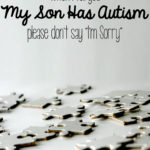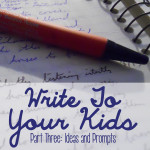This shop has been compensated by Collective Bias, Inc. and its advertiser. All opinions are mine alone. #FeedDogsPurina #CollectiveBias
![Dogs may be man's best friend, but for many kids with autism, dogs can provide so much more than friendship. Should your child with autism have an autism companion dog? Here are a few things that they can help with. #FeedDogsPurina [ad]](http://i.imgur.com/bfbDKD3.jpg)
It takes a village to raise a child, clearly. In many ways, it seems it takes even more of a village to raise a child with autism. For children with autism, you aren’t just talking about family and friends in your village. Your village includes therapists, speech therapists, and other doctors, too. But sometimes the best possible village has 4 legs instead of 2, and that’s where autism companion dogs come in.
Not to be confused with trained service dogs, companion dogs are those special pets that fill a need in the life of a child with autism without training. It’s why I am a big advocate for children with autism having a companion dog in their lives. Autism companion dogs are amazing creatures; they’re loving, calming, and passionate about helping their human companion in their struggles. Here are my 5 reasons that kids with autism need an autism companion dog. (Keep reading, too, because I have a fun DIY dog toy for the beloved pet in your life!)
What does an Autism Companion Dog help with?
Autism companion dogs help children with autism in so many ways. They can help children with autism build confidence. They also give them someone to confide in, because whether your child is verbal or non-verbal, a dog gives that sense of understanding. And, companion dogs can help children with autism stay calm. Because every child with autism is different, the help a companion dog can provide is different, but here are a few things I’ve seen in my son’s interactions with his companion dog, Echo.
His autism companion dog helps him sleep better.
My son often struggles with sleep. Some nights include multiple nightmares. Others have sensory struggles with blankets and clothing. And some nights, his brain just won’t stop talking long enough for him to relax. However, Echo is a huge help with the sleep process and helps him fall asleep (and stay asleep) by cuddling close with him. While often things like weighted blankets can help with comfort, it can sometimes be a struggle for kids with special sensory needs to fall asleep under them. A companion dog can be nearby for warmth and weight as needed, then move if they notice the child is feeling more stressed.
![Dogs may be man's best friend, but for many kids with autism, dogs can provide so much more than friendship. Should your child with autism have an autism companion dog? Here are a few things that they can help with. #FeedDogsPurina [ad]](http://i.imgur.com/GhSMussg.jpg)
His autism companion dog can help him calm down during a meltdown.
When my son is melting down, it can be hard to calm him down at all. I’ve talked before about how a meltdown is not the same as a temper tantrum, but when it’s happening, he can feel hopeless to stop it, and we can feel hopeless to help. Luckily, Echo is right there to step in and help him feel better during those stressful meltdown moments.
When a human intervenes in a meltdown, they’re more likely to tell the child to calm down, and demand to know why the child feels this way in the first place. Dogs don’t ask questions, dogs don’t demand answers, and dogs don’t talk in a way that can provide one more source of stimulation if a child is already overstimulated. It’s very clear that the quiet nurturing a dog provides is very helpful, and it’s also clear that petting a dog can be incredibly calming. In the same way, many neurotypical people feel calmed by petting a beloved animal, non-neurotypical children can feel that, as well.
![Dogs may be man's best friend, but for many kids with autism, dogs can provide so much more than friendship. Should your child with autism have an autism companion dog? Here are a few things that they can help with. #FeedDogsPurina [ad]](http://i.imgur.com/No9858Y.jpg)
His autism companion dog helps reduce his overall anxiety.
In his day-to-day life, autism and related disorders can cause some struggles for my son. While Echo is a huge help in making sure my son can calm down during a meltdown, he is also very key in making sure he doesn’t get there in the first place. When humans are around dogs, something about the interaction between humans and dogs releases extra cortisol in the human brain, according to a study by the University of Montreal. Cortisol is an amazing hormone released by our bodies that helps to lower stress. It works well in children with autism, helping them feel calmer overall and avoiding those anxious thoughts that can lead to repetitive behaviors and frustration.
![Dogs may be man's best friend, but for many kids with autism, dogs can provide so much more than friendship. Should your child with autism have an autism companion dog? Here are a few things that they can help with. #FeedDogsPurina [ad]](http://i.imgur.com/kA1rAOx.jpg)
His autism companion dog helps him with social skills and communication.
Sometimes children with autism struggle to read non-verbal cues and can have trouble with communication and social skills. Companion dogs help with that in so many different ways. For one, my son loves to jump on the trampoline with Echo (and by jump, I mean sit and play or snuggle). He has learned that if he asks Echo to join him on the trampoline and Echo doesn’t follow, that means no, thank you. If Echo follows, it means he will be patient with being lifted onto the trampoline. Following Echo’s non-verbal cues helps my son understand those non-verbal cues in others, as well.
Echo also helps him feel more confident in his speech and communication skills (dogs don’t judge!), which helps him later communicate with other humans. At first, he would often sit next to Echo and make pretend phone calls to friends and family. Now, he is able to make actual phone calls to our family without stress, and part of that is because of Echo’s quiet listening as he practiced on his own.
![Dogs may be man's best friend, but for many kids with autism, dogs can provide so much more than friendship. Should your child with autism have an autism companion dog? Here are a few things that they can help with. #FeedDogsPurina [ad]](http://i.imgur.com/4U4rQOT.jpg)
His companion dog gives him a manageable chore and teaches him responsibility.
Tending to Echo is very much my son’s favorite chore. It’s very important to him to give him the care he needs, like bathing him, getting his food and water, and spending time with him. These things are all great parts of caring for a pet that can teach any child responsibility and care for other animals, but it is especially important for children with high-functioning autism to have something very tangible to do each day outside of cleaning and personal hygiene. My son knows exactly what his companion dog needs each day, and makes sure that he gets it. As his parent, I tackle the big things, like vet appointments and routine vaccination, but it’s on him to help feed and bathe Echo when he needs it.
![Dogs may be man's best friend, but for many kids with autism, dogs can provide so much more than friendship. Should your child with autism have an autism companion dog? Here are a few things that they can help with. #FeedDogsPurina [ad]](http://i.imgur.com/vBvJzg5.jpg)
By being actively engaged in Echo’s care, it also serves as a good reminder of why it’s important for him to take care of himself, as well. Some kids with autism struggle with personal hygiene, but if he and Echo play in the dirt and he feels that Echo needs a bath, I can point out how that is a pretty good indicator he could use a bath, as well. If Echo needs his nails trimmed, and is super brave for me trimming them, it helps show my son that he can be brave to have his nails trimmed as well. Echo serves both as a pet my son needs to tend to, but also a role model for my son to look up to, making him a great fit for our family.
How to Care for your Autism Companion Dog
Obviously, a good companion doesn’t just help the humans in his life. He also gets love and affection from them in return. To care for your autism companion dog, you’ll want to be sure he gets regular checkups and vaccinations. You’ll also want to be sure he is groomed when required for his breed. He needs to have time to rest and regenerate from his time spent with his best friend.
We make sure Echo gets plenty of solo rest time, as well as plenty of love and snuggles. When I rescued Echo before my son was born, I didn’t know that he would be the perfect fit as an autism companion dog. He grew into that role and took it on himself. However, he had that nurturing spirit and companion personality from the beginning. When choosing a companion dog, you want to make sure you can find one to adopt with that nurturing and compassionate spirit.
![Dogs may be man's best friend, but for many kids with autism, dogs can provide so much more than friendship. Should your child with autism have an autism companion dog? Here are a few things that they can help with. #FeedDogsPurina [ad]](http://i.imgur.com/hEe1Qp0.jpg)
We also try to ensure that Echo has the best nutrition we can provide, in the form of Purina One® Smartblend® Chicken and Rice Formula Adult Premium Dog Food. It’s food that Echo loves to eat, and we know it’s a good choice for him. My son likes the bag because it’s his favorite color, red, but I like the nutrition that is contained inside.
![Dogs may be man's best friend, but for many kids with autism, dogs can provide so much more than friendship. Should your child with autism have an autism companion dog? Here are a few things that they can help with. #FeedDogsPurina [ad]](http://i.imgur.com/vv0XXuK.jpg)
Purina One Smartblend Chicken and Rice has real chicken as the first ingredient blended with other high-quality protein sources, helping promote strong muscles and a healthy heart. It’s great that his food gives him a healthy heart since he has such a loving heart. Keeping it healthy longer is a big deal to us.
![Dogs may be man's best friend, but for many kids with autism, dogs can provide so much more than friendship. Should your child with autism have an autism companion dog? Here are a few things that they can help with. #FeedDogsPurina [ad]](http://i.imgur.com/LsftbBm.jpg)
It also contains Omega-6, which help keep his coat healthy. While we’re giving him baths to make sure it’s nice and clean, his fur feels so soft and protects him well because of the Omega-6 in his food.
Plus, it has natural sources of glucosamine to help his joints. I love that because as Echo gets older, it seems we still see him running and jumping like he’s a puppy.
![Dogs may be man's best friend, but for many kids with autism, dogs can provide so much more than friendship. Should your child with autism have a companion dog? Here are a few things that they can help with. #FeedDogsPurina [ad]](http://i.imgur.com/8PA0wdJ.jpg)
We also love that it’s available in the Pet Care aisle of our local Target store. It means we can pick some up anytime we’re there to do our shopping. It’s extra convenient and priced perfectly while being really easily digestible to go straight to work in Echo’s body. It doesn’t matter if you’re buying Purina One or another great Purina pet food like Beneful. You’re sure to find the perfect fit for your dog in the Pet Care aisle of your local Target store!
DIY Dog Toy Instructions
Autism companion dogs, like all dogs, need good food like Purina One Smartblends, affection, and of course, fun. Echo loves to spend time on the trampoline playing with my son. That said, you can’t beat a good chew toy for plenty of fun! One great way to get your child with autism involved is to have them make a toy for their dog. This allows them to show their appreciation for the way their dog helps take care of them.
![Dogs may be man's best friend, but for many kids with autism, dogs can provide so much more than friendship. Should your child with autism have a companion dog? Here are a few things that they can help with. #FeedDogsPurina [ad]](http://i.imgur.com/HxYmbV0.jpg)
We made this dog toy affordably and easily, and it doesn’t take long at all! First, you’ll want to take an old tee shirt or tank top that is strong and sturdy. Using scissors, cut the shirt into three thick strips. From there, you can just braid the shirt and tie a knot at each end. If a braided toy isn’t quite fun enough, you can choose to make the shirt toy squeaky!
We opted to make the shirt squeaky by adding in a few mini tennis balls with a squeak function. However, any small squeaky toys will work well. Secure them tightly within the shirt, keeping braids as tight as you can. If needed, use non-toxic glue or sew the opening closed. Knot each end securely, and you’re ready to play!
![Dogs may be man's best friend, but for many kids with autism, dogs can provide so much more than friendship. Should your child with autism have a companion dog? Here are a few things that they can help with. #FeedDogsPurina [ad]](http://i.imgur.com/GezuNzn.jpg)
For very active dogs, these are perfect for playing tug of war or fetch with. They’re also soft and cozy enough that they make a great dog comfort toy for dogs who are more restful, as well. Echo prefers to cuddle with his dog toy than to play with it, but either way, he loves it!
Does your child have a furry companion?
Tell me all about your child’s furry companion in the comments below! And don’t forget to pick up one of the awesome Purina brand pet foods at your local Target store. Right now, there’s even a special Cartwheel offer for 20% off of select Purina brands. Depending on the week, the exact food in the promotion may vary, but if you’re a Purina fan or have been looking for a reason to switch your furry friend to Purina, now is a great time to shop!
Simply click on the image above or click right here to access those great Cartwheel offers! You can even find your favorite Purina dry foods on the Target website here.
I can’t wait to hear more about your favorite furry companions in the comments!
More Autism Resources
When raising your child with ASD feels like raising the Incredible Hulk
How to handle your child’s meltdowns
When I tell you my son has Autism, please don’t say “I’m sorry.”
Are Pets the Key to Treating Autism? from the DailyMail
Pets May Help Improve Social Skills of Children with Autism from Huffington Post
More Pet Resources
Hamster Food Smoothie Recipe
Cute Puppy Cake Pops from Moms and Munchkins
List of Great Companion Dog Breeds from Purina
Note: I am not an autism specialist, nor am I a dog expert. This post is written to share my son’s experience with his companion dog, but your mileage may vary. Be sure to take careful consideration when choosing the right dog for your family, whether or not your furry friend will be a companion for your child with autism or not.

![Dogs may be man's best friend, but for many kids with autism, dogs can provide so much more than friendship. Should your child with autism have a companion dog? Here are a few things that they can help with. #FeedDogsPurina [ad]](http://i.imgur.com/eNy7e7v.png)




hi jenni! loved this post. what do you think is a good age for a child to get a dog? also, are there any breeds that you think work well for autistic children?
Amazing information! I’m so glad your son has such a perfect companion, thanks for sharing all that you’ve learned. I also love that toy DIY – going to make a few for my 2 dogs! [client]
I’m so glad you like these! They’re super simple to make, which makes them a really easy DIY!